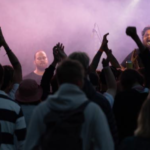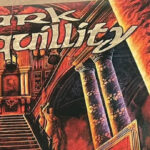Portugal’s progressive rock sensation, Needle, has been carving its unique sonic path with a lineup featuring Soraia Silva on Vocals, the twin guitar wizardry of Luís Costa and Tiago Sousa, the rhythmic prowess of Kevin Mota on Bass, and the driving force of Luís Pereira on Drums. Drawing inspiration from the likes of Opeth, Tesseract, Vola, and Porcupine Tree, Needle weaves a tapestry of intricate melodies and complex rhythms that resonate deeply with fans of the genre. In an exclusive interview with Extramusic, the band delves into the creative depths behind their latest masterpiece, “Fall.” This highly anticipated album has been generating waves in the prog rock scene, showcasing Needle’s evolution as musicians and storytellers. Join us as we uncover the inspirations, challenges, and musical journey that shaped this exceptional release.
Your fusion of female vocals with djent elements in “Fall” has been noted as a unique signature style. What inspired this juxtaposition of contrasting elements in your music?
Needle was born out of a previous band evolution we could say, were the original line-up was almost all part of. This being said, our previous project had a female lead voice as well, and Soraia filled in for what it would it’s last ever concert. After that we started to write new materiel in a total different direction than before, and so Needle began.
All this to say that, it wasn’t completely intentional to have female vocals, it felt natural to us to take on that route.
On regards to the djent elements, we never written anything with the intention of being part of some genre or style in of itself, but obviously modern progressive music is a big influence for us. Basically, there was no premeditative intent on the “Needle sound”, so to speak, it is just a collection of external factors that lead us here, hoping that it connects with someone.
The review acknowledges moments where your music stands out for its softer, more distinct tones. How do you balance these softer elements with the heavier, more generic aspects of the djent style?
We try to have both side of the spectrum, meaning, different tones can resemble different feelings or emotions that help convey a song’s message and meaning.
The balance is not always that easy to find, sometimes it may feel too abrupt, or maybe to obvious, but ultimately we tend to choose and stick to what feels right for each part.
Can you elaborate on the creative process behind integrating ethereal and jazzy tones into your music, as observed in tracks like “Calliope”?
Calliope is definitely a good example of what we addressed in the previous answer.
In the jazzy mid-section of Calliope, we aimed to resemble some kind of self-introspective and peaceful moment that the main character of the song is having.

How did you plan to evolve the instrumental aspects of your music while maintaining the uniqueness brought by Soraia Silva’s vocals?
We never did or continue not to make plans on the Band’s creative trajectory.
In a somewhat selfish way, the end goal for us is to make music that we feel good hearing, and are confident enough to share with people.
In what ways do you believe your music challenges or reinvents the typical conventions of the genre?
To be quiet honest, we do not feel we are reinventing anything.
But we do feel that we may fit in the progressive music world, almost as an self-excuse to write on any terms we feel to.
Anyhow we are aware that lead female voices are something relatively recent in this niche of the musical world, but bands such as Kalandra, Spirit Box or even Earthside (with recent guest features) are leading the flag on breaking some of this typical conventions.
How do you approach creating a cohesive narrative or progression within your albums?
Up until this point, we haven´t done a conceptual work, so there isn’t an inherent need to have a specific order.
So what we typically do is nothing that much interesting, we only listen to the songs individually and then we sit together and discuss the “flow” the work in question should have, and do the track list in conformity.
Your album “Fall” has been described as stitching together contrasting elements. How intentional is this duality in your music, and how do you ensure a balance between these opposing sounds?
We definately do not write with a style in mind.
To a certain extent, we can only hope that these contrasting elements don’t clash in an unpleasant way to the listener. It surely occurred in writing process instances were things got way over the top, regarding composition, and usually it is discussed between the 5, hopefully in order to find this balance.
What role do you believe experimentation plays in pushing the boundaries of your music, especially considering the genre’s established characteristics?
Experimentation has been and will always be what define us as human beings, and ultimately what made us evolve over the centuries.
Certainly the same principle applies for music in general, and consequently ours.
We try to innovate on every single thing we do, not that we are aiming to reinvent the wheel, but in challenging ourselves on a personal level, this being with using new technologies, discovering new music to get inspiration from, or even learning and implementing a new instrument in our music, who knows.
All in all, if there is love for what is it that you’re creating, there’s always a chance of coming up with something new, and that’s what we strive to do.



